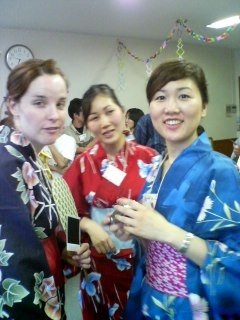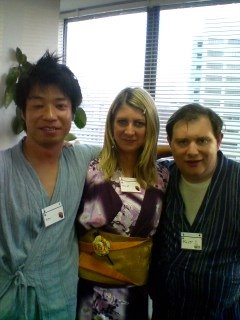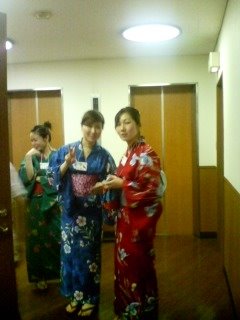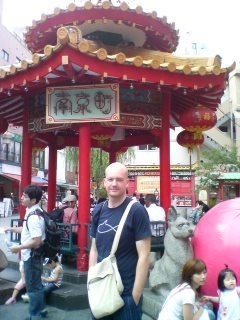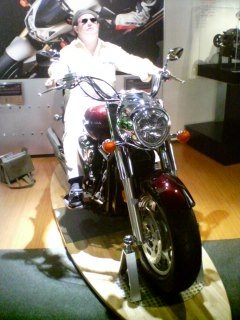
There are three major festivals in Japan, and the Gion Matsuri in Kyoto is one of them. The festival lasts a whole month long, but the real action takes place between the 15-17th of the month. On the 15th and 16th, the floats are available for inspection, and you can go see them, walk around, and look at them up close. On the 17th is the great parade, and, having been to my fair share of parades, as either an observer or participant, I can fairly say that this is the most gorgeous, inspiring, and madhouse filled one of them all. I recommend, if you can, visit the country and see this thing at least once in your life, and you will not regret it. But, come out early, because it becomes crowded, and people with literally push you around if you are not careful--- and this is from Japanese people, who are usually averse to any kind of overt conflict.
I wanted to go early, because I know the nature of parades, but no one else thought that would be as good an idea, and they were not as excited to see it as I was. So, we left at 10am and got there at around 11.30, nearing the end of the parade, so we missed a bunch of the smaller floats. It was driving rain for most of it too, so the sidewalks, which are under a permanant canopy in Kyoto, were filled to the gills with people. But, despite the weather, the great floats rumbled on. It is quite a feat to see them move around, because there is no mechanization, like with the floats you have in the US. Twenty or so big, strong men pull each one, and to make it turn is a testimony of stregnth and desire. I wanted to take a movie of this, but too many people were in the way. And, seemingly as soon as we got there, it was over, which made me a little disapointed, because I started to get into the spirit of things.
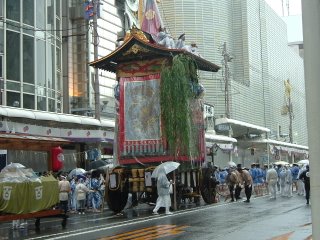
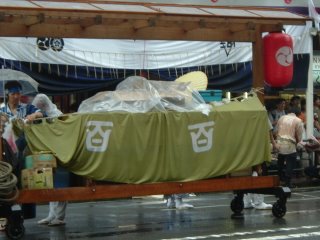
We walked around Kyoto a little, following the path the floats take, and eventually caught up with the three big ones again. The largest of them all was making music, a traditional song which has been handed down since time immemorial, and is now associated with the festival. So much so, that, when you go in the underground mall in Kyoto, they pipe the music in, sort of like malls do for Christmas music in the West. We saw the pulling of the float, and I bought a replica of one of them too.
The festival started out as a way to persuade the Brother of the Sun Goddess to cure all of Japan of a plague in 869 AD. His spirit, transfered to large, float like palaquins, was carried through the city by the strongest men from around. The spirit woke, got to the job, and the plague lifted soon after. As a thank you, Kyoto now takes out the divinity for a drive every year at this time, and the end result is magnificient.
Also available for view are the thousands of large and small temples and shrines, Buddhist and Shinto alike. The Buddhist shrines make the most magnificient floats, and these are housed in special buildings for most of the year, until they come out for parade time. We went into a few.
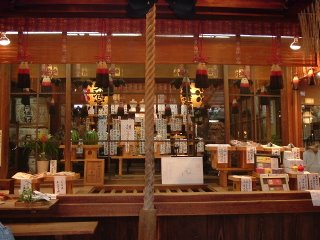
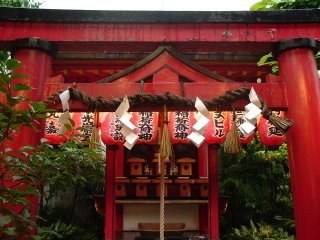
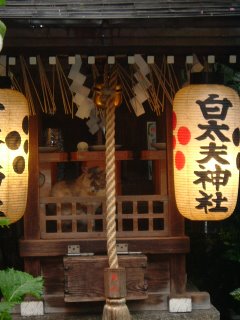
This is one of the smaller temples, but it has a courtyard where you can walk around and see many small shrines for veneration, in addition to the larger one which is full of Buddha statues and candles, and incence, and so on. If you look closely in the middle picture, you will see a cat hanging out in the shrine. I was not able to find out why. It could be that the cat spirit is supposed to be there. It could be that the cat is not supposed to be there, and just being a cat and sitting around. *
We walk around a little more, and went into one of the larger temples. It is easy to find a temple in Kyoto by and large, but especially on the Teramachi, which literally means "Temple Street." As a means to consolodate religious power, the 16th Century Shogun, Hideyoshi, ordered all temples into one place, so that their influence would be concentrated there. Eventually, all the stores related to religion, incence peddlers, medicine stores, candle makers, what have you, congregated there too. And, over more time, stores in general opened, making the street the curious mix of capitalism and contemplation. It is one of the interesting facts that you can hear the busy hawking of wares from inside the temple grounds, which is the backdrop to meditation for the monks. In this way, the temples become islands in the floating world, and stand testemony to how all is impermanent and false, because you can find peace of mind and the persuite of money, side by side.
The second temple we went to was much larger, and the inside had very comfortable tatami mats. It was good to kick off the shoes, and relax in a quiet space for a while, and soak in the place. Interspersed between the real candles were electric ones, and there were also candles you could purchase.
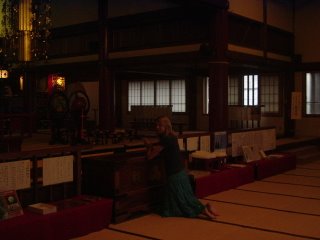
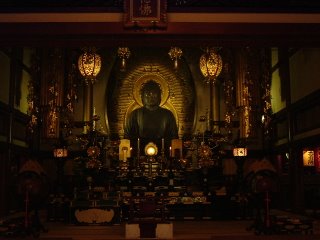
Here is a close up:
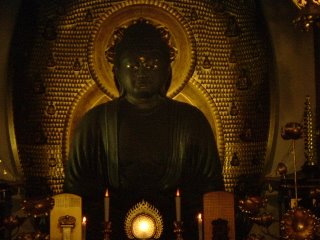
This buddha is one of the largest I have seen, outside of a museum. There are several much larger, but this one seems very much at meditation, and is well kept.
After this, we shopped around a bit, and then headed back home. In some ways, I am glad it was as damp as it was, because it meant fewer people overall, even though it was a pain to carry umbrellas with us. I should have more photos for you from next week's excursion, because i still have much to investigate.
*as the festival actually lasts for a month, and next week the floats will be availble for inspection again, i am going to go to get another look. At that time, I hope that I can find someone to talk to about many of the questions I have. The Japanese with me on this excursion did not know too terribly much about any of the rationale behind anything, which is disheartening in two respects, first, that they were not able to give me instant gratification about knowledge, and second, that there is no special hold for any culture for not paying attention to the spiritual, because if you were to ask most Americans about the meanings of their own religious symbols, you will get blank stares and baleful looks, too. People, really, it is worth investigating, if only from an anthropological viewpoint.









